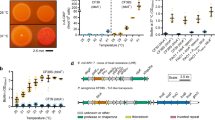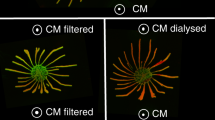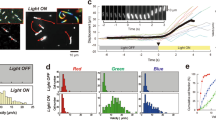Abstract
STARVATION triggers the differentiation of Dictyostelium discoideum amoebae to aggregation competence. The differentiated cells orientate and migrate towards attracting centres, presumably consisting of amoebae which autonomously and rhythmically emit cyclic AMP as a chemotactic signal. Signals, emitted with a periodicity of 5–8 min (refs 1–3, 5), are presumably generated by rhythmic changes in adenylate cyclase activity6, levels of which dramatically increase during the first few hours before the expression of aggregation competence7,8. Cellular responses to external cyclic AMP are probably mediated by plasma membrane receptors9. When stimulated by a pulse of cyclic AMP, amoebae amplify10 and relay1,5,10,11 the chemotactic signal, which results in a coordinated aggregation. The decay of the chemotactic signal is determined by the activity of the extracellular cyclic AMP phosphodiesterase12,13 whose activity is modulated by an inhibitor excreted by cells during the early hours of starvation14. Cyclic AMP pulses have recently also been shown to regulate the differentiation of cells to aggregation competence15. To determine their mechanism of action, we examined the influence of applied cyclic AMP pulses on the two earliest biochemical events implicated in the control of cyclic AMP levels, the rise in adenylate cyclase activity and the appearance of the extracellular phosphodiesterase inhibitor. The results show that adenylate cyclase may exist in active or inactive forms. Applied cyclic AMP pulses seem to induce cell differentiation by activating the enzyme. They also are shown to repress the production of the phosphodiesterase inhibitor.
This is a preview of subscription content, access via your institution
Access options
Subscribe to this journal
Receive 51 print issues and online access
$199.00 per year
only $3.90 per issue
Buy this article
- Purchase on Springer Link
- Instant access to full article PDF
Prices may be subject to local taxes which are calculated during checkout
Similar content being viewed by others
References
Shaffer, B. M. Adv. Morph. 2, 109–182 (1962).
Bonner, J. T. The Cellular Slime Molds 2nd edn (Princeton University Press, Princeton, 1967).
Gerisch, G. Curr. Top. dev. Biol. 3, 157–197 (1968).
Konijn, T. M., van de Meene, J. G. C., Bonner, J. T. & Barklay, D. S. Proc. natn. Acad. Sci. U.S.A. 58, 1152–1154 (1967).
Robertson, A., Drage, D. J. & Cohen, M. H. Science 175, 333–334 (1972).
Goldbeter, A. & Segel, L. Proc. natn. Acad. Sci. U.S.A. 74, 1543 (1977).
Klein, C. FEBS Lett. 68, 125–128 (1976).
Klein, C. FEMS Lett. 1, 17–20 (1977).
Malchow, D. & Gerisch, G. Proc. natn. Acad. Sci. U.S.A. 71, 2423–2427 (1974).
Roos, W., Nanjudiah, V., Malchow, D. & Gerisch, G. FEBS Lett. 53, 139–142 (1975).
Shaffer, B. M. Nature 255, 549–552 (1975).
Bonner, J. T., Barkley, D. S., Hall, E. M., Konijn, T. M., Mason, J. W., O'Keefe, G. & Wolfe, P. B. Devl Biol. 20, 72–87 (1969).
Chang, Y. Y. Science 160, 57–59 (1968).
Gerisch, G., Malchow, D., Riedel, V., Muller, E. & Every, M. Nature new Biol. 235, 90–93 (1972).
Darmon, M., Brachet, P. & Pereira da Silva, L. Proc. natn. Acad. Sci. U.S.A. 72, 3163–3166 (1975).
Gerisch, G., Malchow, D., Huesgen, A., Nanjundiah, V., Roos, W., Wick, U. & Hülser, D. in Proceedings of the 1975 ICN-UCLA Symposium on Developmental Biology (eds by McMahon, D. & Fox, C. F.) (1975).
Klein, C. & Darmon, M. Biochem. biophys. Res. Comm. 67, 440–447 (1975).
Gerisch, G. & Hess, B. Proc. natn. Acad. Sci. U.S.A. 71, 2118–2122 (1974).
Klein, C. & Brachet, P. Nature 254, 432–433 (1975).
Roos, W. & Gerisch, G. FEBS Lett. 68, 170–172 (1976).
Watts, D. J. & Ashworth, J. M. Biochem. J. 119, 171–194 (1970).
Beug, H., Katz, F. E. & Gerisch, G. J. cell Biol. 56, 647–658 (1973).
Juliani, M. H. & Klein, C. Biochim. biophys. Acta 497, 369–376 (1977).
Lee, C. K. J. gen. Microbiol. 72, 457–471 (1972).
Gerisch, G., Fromm, H., Huesgen, A. & Wick, U. Nature 255, 547–549 (1975).
Author information
Authors and Affiliations
Rights and permissions
About this article
Cite this article
KLEIN, C., DARMON, M. Effects of cyclic AMP pulses on adenylate cyclase and the phosphodiesterase inhibitor of D. discoideum. Nature 268, 76–78 (1977). https://doi.org/10.1038/268076a0
Received:
Accepted:
Published:
Issue Date:
DOI: https://doi.org/10.1038/268076a0
This article is cited by
-
PSF and CMF, autocrine factors that regulate gene expression during growth and early development ofDictyostelium
Experientia (1995)
-
Induction of cell contact sites by Ca2+-EDTA pulses inDictyostelium discoideum
Experientia (1982)
-
pdsA, a gene involved in the production of active phosphodiesterase during starvation of Dictyostelium discoideum amoebae
Molecular and General Genetics MGG (1980)
Comments
By submitting a comment you agree to abide by our Terms and Community Guidelines. If you find something abusive or that does not comply with our terms or guidelines please flag it as inappropriate.



